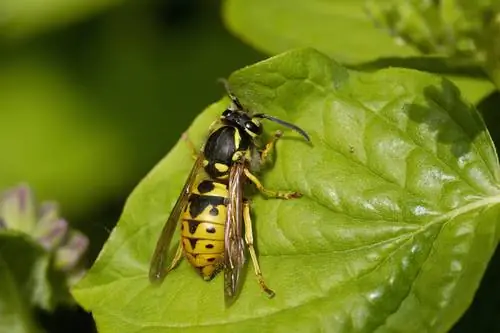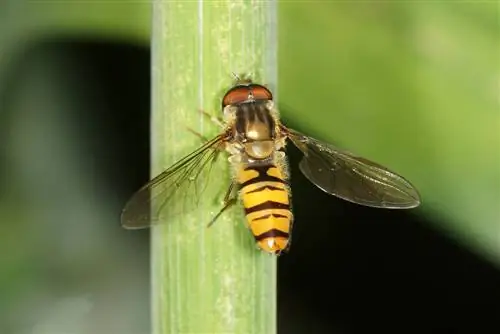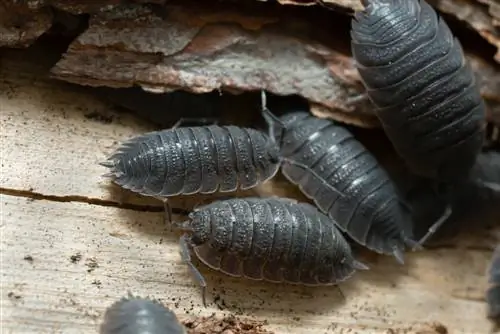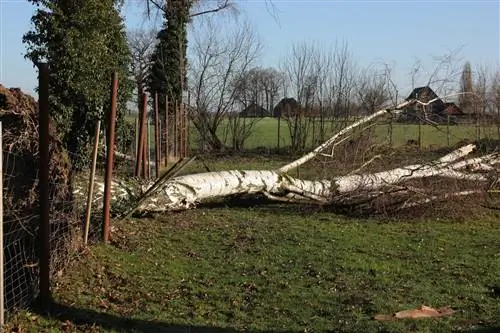- Author admin [email protected].
- Public 2023-12-16 16:46.
- Last modified 2025-01-23 11:19.
Storm animals do not have a good reputation because they have become known as nuisances and pests. However, numerous details about the biology and lifestyle of insects remain hidden to nature lovers. It's worth taking a closer look, because the insects have very specific intentions with their behavior.

What helps against thunderstorms?
Thunderstorm animals appear suddenly and take advantage of good living conditions. When they settle on houseplants, they find a rich supply of food and multiply en masse. Gentle methods or home remedies have proven effective in getting the spread under control. You should generally avoid chemical insecticides. These endanger your he alth and not only harm unwanted insects.
Tip
The tiny insects are magically attracted to blue colors. To detect an infestation, you can place a blue cloth on the windowsill next to your plants.
Show off
You can gently get rid of the pests by spraying your plants with a hard jet of water. In this way the insects are washed away. Don't forget the undersides of the leaves, as the insects can use their bubble feet to cling to smooth surfaces. This method is suitable if the infestation has not yet passed the initial stage.
Soap suds
This home remedy is particularly gentle and not only helps against thrips. Mix one liter of water with two tablespoons of oil and add a splash of dish soap. Alternatively, you can dissolve 15 grams of soft or curd soap in the same amount of water. The solution is distributed with a sprayer so that the entire plant is misted. The treatment should be repeated over several days, spraying the plant with pure water every other day. This prevents pores from becoming clogged.
Stinging nettle broth
Some herbs help in pest control because their ingredients and essential oils not only promote he alth but also repel insects. For a nettle decoction you need about 500 grams of fresh leaves, which are poured over with five liters of boiling water. You can enhance the effect with garlic or onions. Let the mixture steep for 24 hours and spray the plant every few days with the undiluted broth.
Neem oil
The oil is obtained from the seeds of the tree of the same name. It contains the active ingredient azadirachtin. This has an insecticidal effect and prevents the larvae from molting into adult insects. Adult insects cannot be controlled with neem oil. Dab the larval clusters with a cotton swab soaked in oil. Use additional means to combat the plague.
Glue traps
This special trap has been coated with glue so that flying insects stick to the surface after landing. Blue panels are particularly effective at attracting thrips. However, this method is only suitable for checking for a possible infestation and not for combating it. Wingless stages and species are not caught by the trap and can continue to reproduce.
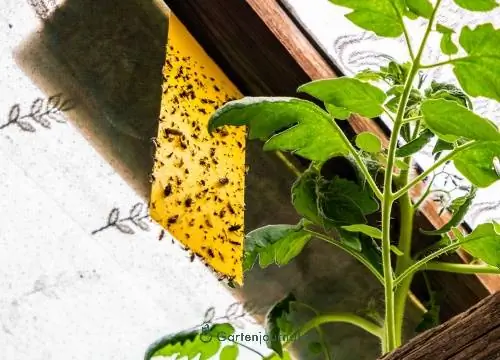
Sticky traps attract thrips and cause them to die in agony
Use beneficial insects
In closed rooms such as greenhouses or winter gardens you can spread beneficial insects that ensure a natural containment of the thrips population. Predators include flower bugs, lacewing larvae and predatory mites. The beneficial insects can be purchased online or in garden stores. If you use beneficial insects, you should avoid using other control methods. Otherwise you endanger the survival of the beneficial insects. You should also make the living conditions optimal for the beneficial insects. Adjust temperature and humidity accordingly.
| Temperature | Humidity | |
|---|---|---|
| Predatory mites | 22 to 26 degrees Celsius | 70 to 80 percent |
| Flower Bugs | 18 to 25 degrees Celsius | 60 to 95 percent |
| lacewings | 20 to 26 degrees Celsius | undemanding |
Excursus
Lifespan of thunderstorm animals
The lifespan of thunderstorm animals depends very much on the climate. In warmer regions, one generation often survives for an entire year; in colder regions, several generations are born and die each year. If you want to wait until the storm animals die on their own, you can wait a long time, because they reproduce asexually - and in large numbers. It takes about 20 days from egg to insect; the adult thrips can live for several weeks to months.
From egg to adult storm animal
The biology of thunderstorm animals has been very well researched and yet still holds many secrets. Since the order contains several families and genera, the way of life is very different.
Reproduction and larval development

Thunderstorm animals can reproduce asexually
Most fringed-winged birds develop several generations per year, provided the weather conditions are optimal. Permanently warm greenhouses promote mass reproduction. In temperate climates, storm animals only develop one generation per year. The insects predominantly reproduce through asexual reproduction. There are some species that only produce females.
The larvae develop from the eggs within two to 20 days. They then display different lifestyles depending on the species. Some remain on the surface, while other fringed wing larvae retreat into the substrate. Their appearance and lifestyle are similar to adult fringed wings, but they have no wings.
Further larval development:
- two larval stages are followed by a prepupal stage
- Prepupal stage partially takes place in the cocoon
- then one or two more doll stages
Food
Just like green aphids, the black thunderbirds also feed primarily on plant juices. They pierce individual cells with their mouthparts and suck the liquid out of them. The plant tissue dies and turns light to shiny silver. While some species are specialized on certain host plants, other fringe beetles feed on plant juices from different species. There are also representatives that feed primarily on bollards.
Food spectrum of the fringed winged winged beetle:
- predatory species feed on mites, scale insects and eggs
- some species use mushrooms on dead wood as food
- some fringed winged birds develop plant galls in which they eat plant tissue
Dissemination
Fringewings are dispersed by the wind for hundreds or thousands of kilometers because of their low weight. They are therefore considered aerial plankton because they cannot actively change their direction of flight. With the exception of the polar regions, fringed-winged birds have spread worldwide. Even wingless species could be carried across the seas by the wind. The plant trade, which has been carried out since the Middle Ages, also contributes to the spread of insects. Fringed-winged winged birds are mainly distributed in the tropics.
Wintering
In Central Europe, some adult fringed-winged birds survive the winter. The larvae rarely overwinter. They escape from unstable habitats such as grain fields and look for sheltered retreats. They prefer to retreat into loose soil or litter, but also crawl into cracks and crevices under tree bark. Narrow wintering quarters that ensure physical contact on all sides are ideal. This means that it is more common for storm animals to come into close proximity with humans. They occasionally set off fire alarms when they enter the tight spaces.
Prevention
A pest infestation is difficult to prevent because the insects can appear suddenly. However, you can ensure that the living conditions are not optimal for the fringe-winged birds. Optimal plant care also plays a major role in prevention.
Humidity

Thrips cannot tolerate moisture
Thrips like dry air. If your plants have been infested, temporarily put them in the bathroom or spray the plants regularly. When the humidity is high, the reproduction of the fringed winged beetles is extremely limited.
In winter, place bowls filled with water on the radiators so that there is a humid microclimate above the windowsill. A large planter filled with gravel collects excess irrigation water, which can then evaporate. Clay pots regulate the water balance in the substrate and direct excess water to the outside, where it evaporates on the surface.
Change substrate
After you have identified an infestation and successfully combated the pests, you should repot the plant. Larvae of the fringed winged winged winged beetle live on or in the substrate, where they pupate. If you do not completely replace the substrate, the insects may appear again next year.
Tip
Prevent waterlogging as this weakens your plants. If your immune system is already attacked, pest infestation is encouraged.
Overview and naming
Thunderbirds, which are officially referred to in German as fringed wings, represent the order Thysanoptera. Long hair fringes on the edges of the wings are characteristic. There are around 5,500 species worldwide, including 400 in Central Europe. More than 200 species occur in Germany. The name thunderstorm animal comes from the way these insects live. They always seem to appear in large numbers when a summer thunderstorm is about to occur.
Old dialect names for thunderstorm animals:
- Ostfriesland: Gnidd or Putsigel
- Sudetenland: Little Weather Spirit
- Rhineland: Flickers or Hommelfrogs
- Flensburg: Kaulpanne
Bubble feet
The insects have flap-like structures on the end members of their legs called arolium. You can increase the internal pressure so that the lobes inflate like a balloon. These special structures enable storm animals to cling to smooth surfaces. To further improve adhesion, the insects wet their feet with a secretion.
Thrips
In Germany, 26 species are listed as pests that cause problems in agriculture and plant breeding. Common pests include onion thrips (Thrips tabaci) and Parthenothrips dracaenae. Thrips is the scientific term for a genus within the fringed winged insects, which was adopted in German.
Grain pests in Central Europe:
- Limothrips cerealium
- Limothrips denticornis
- Haplothrips aculeatu
Recognize
Frenched-winged winged winged beetles reach a size of between one and three millimeters. Your body is comparatively elongated. The highly modified and asymmetrical mouthparts are characteristic of storm animals. While the right upper jaw has receded significantly, the left upper jaw has developed into a prickly bristle. These mandibles are used to pierce plant tissue and suck up the sap. Adult insects have four narrow wings, although some species are wingless. The larvae are green in color and translucent.
Danger of confusion: white and black flies
This term is occasionally also used for thunderstorm animals, which can lead to confusion. Black flies mainly refer to fungus gnats, which belong to the order Diptera. They represent a genus within the mosquitoes. Behind the whiteflies are whiteflies, which belong to the order of beaked insects.
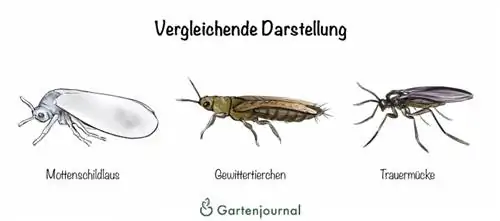
Flight behavior
Thunderstorm animals are not considered flight artists because they can neither fly against the wind nor rise into the air under their own power. The reason for this is the heavily fringed wings, which do not allow any change in direction. Rather, the insects depend on the summer thermals.
They rise with the warm air masses and are carried into higher air layers when the weather is nice and temperatures above 20 degrees Celsius. When the air pressure drops due to an approaching thunderstorm, thunderstorm animals put their wings on their bodies and allow themselves to sink. They end up on the head, in the hair and on the skin.
Interesting facts about the flight:
- Flying speed of ten centimeters per second
- Lower wing beat frequency than mosquitoes
- have no control over direction of flight
Excursus
Physical factors force thunderstorm animals to land
Researchers have found that changing field strength is a significant reason for sinking from higher layers of air. When the weather is nice, the field strength is between 100 and 300 volts per meter. Thunderstorm animals can then drift into higher layers of air. During a thunderstorm, the field strength increases to values of up to 50,000 volts per meter. There is a threat of thunder and lightning. Thunderstorm animals react even at significantly lower field strengths. They put their wings ready at 8,000 volts per meter to get to the ground.
Are thunderstorm animals dangerous?
The black insects are considered annoying companions on warm, humid summer days. They settle on the skin and bite, which can cause itching in sensitive people. However, the insects do not feed on blood. Rather, the bite is an accidental and harmless side effect.
Symptoms after a sting:
- Skin lesions
- red swellings
- partially inflamed areas
Fluid intake
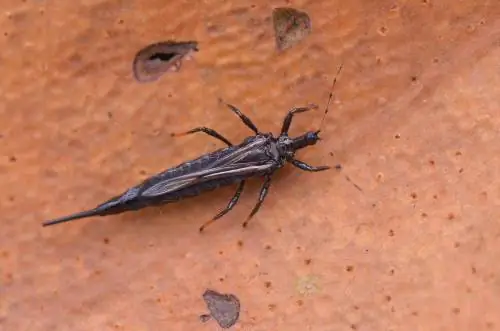
Thunderstorm animals can “bite”
Some fringed wings are able to sting with their mouthparts. Researchers suspect that storm animals are misdirected by sweat secretions and want to absorb moisture. The mouthparts unintentionally scratch the skin. This explains why storm animals seem to prey on athletes' naked limbs.
Looking for protection
Since rain and cold pose great dangers to thunderstorm animals, the insects hide in cracks and crevices when there is a threat of precipitation. After landing on humans, they also crawl under clothing in search of protection. The animals don't usually sting there.
Thunderstorm animals are annoying, but they can't do anything to people. They are not bloodsuckers.
Keep thunderstorm animals away
Bright colors like white or yellow seem to attract storm animals. If you don't want to become a target, you should wear dark clothing. If the insects have settled on your clothing, you can shake them off or remove them with a lint roller. Sunglasses help when jogging so that the fringed wings don't accidentally get into your eyes.
What to do against thunderstorm animals in the apartment?
Frenched-winged flies can easily get into the apartment, even if there is a fly screen on the window. Use a dustpan and broom to sweep the insects off the floor after they settle. Wipe the floor wet or dry with a microfiber cloth. Individual animals can be picked up with an adhesive strip.
Useful or harmful?
Some fringed wings are regular visitors to certain plants. The tropical cycads from the genus Macrozamia are pollinated by storm animals. It is possible that the cycads are even dependent on the cycads of the genus Cycadothrips and cannot reproduce without their help.
Such a dependency is also known from Europe. On the Faroe Islands, common heather can only survive because it is pollinated by heather thrips. It is the only species that can be considered a pollinator. All other insects are eliminated by the strong winds and only the storm animals are carried to the flowers by the wind.
Pollinating thunderstorm animals:
- various types of common heather and heather
- lantana
- Asian Shorea Trees
- exotic Belliolum and Popowia species
Plant pests
Approximately 95 percent of all thrips species are considered pests. They occur as plant suckers on many houseplants such as rubber trees, bow hemp or various orchids. There is often low humidity in the apartment, which is beneficial for insects. Since the animals are tiny and therefore almost invisible to the naked eye, identifying pests is often not easy. The damage patterns can be similar to those of other plant pests.
This is how an infestation by thrips occurs:
- silvery-gray speckles on the leaves
- strong deformations sometimes occur
- Leaves turn brown as the disease progresses
| Nutrition | harmful stage | malicious image | |
|---|---|---|---|
| Spider mites | Plant juice | Insects | silvery spots, fine cobwebs |
| Sad gnats | Hair Roots | Larvae | Seedlings lose stability and wither away |
| Scale insects | Plant juice | Larvae and insects | Plant parts die |
| Aphids | Plant juice | Insects | discolored leaves, sticky coating |
Frequently asked questions
What do thunderstorm animals eat?
The fringed winged birds have a wide range of food. There are purely herbivorous species that feed on the tissues and sap of various plants. Others visit flowers to eat the pollen. There are storm animals that feed on fungi in dead wood and those that are predators. The latter target arthropods and their eggs.
Where do thunderstorm animals come from?
The larvae of the fringed winged winged wing wing live in or on the ground. Here they pupate before being dispersed by the wind as adult insects. Thermal winds carry the insects into high layers of air. When conditions become suboptimal, they fold their wings to their bodies to descend to the ground. This is the case in humid weather before a thunderstorm approaches.
How long do thunderstorm animals live?
The life expectancy of thunderstorm animals varies and depends on the temperature. Although some species are able to overwinter, most fringe-winged birds die after one season. The California flower thrips can survive for around 75 days at temperatures of 20 degrees Celsius. If the thermometer drops to 15 degrees Celsius, the lifespan is only 46 days. Life expectancy also decreases at higher temperatures. At 35 degrees Celsius, the insects die after about nine days.
Why do thunderstorm animals crawl around on the monitor screen?
Liquid crystal monitors in particular have a magical attraction for small insects. They are attracted to the light and crawl through the ventilation slots behind the diffuser film and panel glass. It is visible on the monitor and usually doesn't make it out. When the insects crawl into cracks and crevices, they are looking for protection from cold temperatures and moisture. Niches that offer physical contact on all sides are preferred.
Thunderstorm animals can appear here:
- in cracks behind wallpaper
- on TV
- in the picture frame


